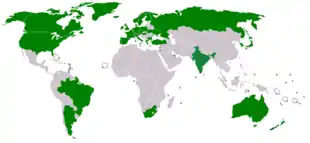
The Missile Technology Control Regime (MTCR) is a multilateral export control regime. It is an informal political understanding among 35 member states that seek to limit the proliferation of missiles and missile technology. The regime was formed in 1987 by the G-7 industrialized countries. The MTCR seeks to limit the risks of proliferation of weapons of mass destruction (WMD) by controlling exports of goods and technologies that could make a contribution to delivery systems (other than manned aircraft) for such weapons. In this context, the MTCR places particular focus on rockets and unmanned aerial vehicles capable of delivering a payload of at least 500 kilograms (1,100 lb) to a range of at least 300 kilometres (190 mi) and on equipment, software, and technology for such systems.
The MTCR is not a treaty and does not impose any legally binding obligations on partners (members). Rather, it is an informal political understanding among states that seek to limit the proliferation of missiles and missile technology.[1]
History
The Missile Technology Control Regime (MTCR) was established in April 1987[2] by the G7 countries: Canada, France, Germany, Italy, Japan, the United Kingdom, and the United States. It was created to curb the spread of unmanned delivery systems for nuclear weapons, specifically systems which can carry a payload of 500 kilograms (1,100 lb) for 300 kilometres (190 mi).
The MTCR applies to exports to members and non-members.[1] An aide-mémoire attached to the agreement says that it does not supersede prior agreements, which NATO members say allows the supply of Category 1 systems between NATO members. An example is the export by the United States of Trident missiles to the United Kingdom for nuclear-weapons delivery.[3]
At the annual meeting in Oslo from 29 June to 2 July 1992, chaired by Sten Lundbo, it was agreed to expand the MTCR's scope to include nonproliferation of unmanned aerial vehicles (UAVs) for weapons of mass destruction. Prohibited materials are divided into two categories, which are outlined in the MTCR Equipment, Software, and Technology Annex. Thirty-five nations are members, with India joining on 27 June 2016.[4]
According to the Arms Control Association, the MTCR has been successful in helping to slow (or stop) several ballistic missile programs: "Argentina, Egypt, and Iraq abandoned their joint Condor II ballistic missile program. Brazil and South Africa also shelved or eliminated missile or space launch vehicle programs. Some former Warsaw Pact countries, such as Poland and the Czech Republic, destroyed their ballistic missiles, in part, to better their chances of joining MTCR." In October 1994, the MTCR member states established a "no undercut" policy: if one member denies the sale of technology to another country, all members must do likewise.[5]
China originally viewed the MTCR as a discriminatory measure by Western governments, which sold sophisticated military aircraft while restricting sales of competing ballistic missiles.[6] It verbally agreed that it would adhere to the MTCR in November 1991, and included the assurance in a letter from its foreign minister in February 1992. China reiterated its pledge in the October 1994 US-China joint statement. In their October 1997 joint statement, the United States and China said that they agreed "to build on the 1994 Joint Statement on Missile Nonproliferation."[7] The Missiles and Missile-related Items and Technologies Export Control List, a formal regulation, was issued in August 2002.[6] The following year, the MTCR chair invited China to participate.[6] China requested to join the MTCR in 2004, but membership was not offered because of concerns about the country's export-control standards.[8][9] Israel, Romania and Slovakia have agreed to follow MTCR export rules, although they are not yet members.[10]
The regime has its limitations; member countries have been known to clandestinely violate the rules.[11] Some of these countries, with varying degrees of foreign assistance, have deployed medium-range ballistic missiles which can travel more than 1,000 kilometres (620 mi) and are researching missiles with greater ranges; Israel and China have deployed strategic nuclear SLCMs, ICBMs and satellite-launch systems. Countries which are not MTCR members buy and sell on the global arms market; North Korea is currently viewed as the primary source of ballistic-missile proliferation in the world, and China has supplied ballistic missiles and technology to Pakistan.[12] China supplied DF-3A IRBMs to Saudi Arabia in 1988 before it informally agreed to follow MTCR guidelines.[13] Israel cannot export its Shavit space-launch system due to its non-member MTCR status, although the Clinton administration allowed an import waiver for US companies to buy the Shavit in 1994.[14]
Over 20 countries have ballistic missile systems.[15] The International Code of Conduct against Ballistic Missile Proliferation (ICOC), also known as the Hague Code of Conduct, was established in 2002. The code, which calls for restraint and care in the proliferation of ballistic missile systems capable of delivering weapons of mass destruction, has 119 members. Its mission is similar to the MTCR's, an export group.
India applied for membership in June 2015 with support from Russia, France and the United States,[16] and became a member on 27 June 2016.[17][18][19]
Pakistan is not a member of the MTCR. Although it has expressed a desire to join the group, it has not submitted an application.[20] The Pakistani government has pledged to adhere to MTCR guidelines,[20][21] and analysts believe that the country is doing so.[20][22][23]
In 2020, the U.S. government announced that it would reinterpret its implementation of the MTCR to expedite sales of unmanned aerial vehicles (UAVs) to other countries. The revised U.S. policy will reinterpret how the MTCR applies to drones which travel at speeds under 800 kilometres per hour (500 mph), such as the Predator and Reaper drones (made by General Atomics) and the Global Hawk drone (made by Northrop Grumman).[24][25]
Members
The MTCR has 35 members.[26]
 Argentina, 1993[26]
Argentina, 1993[26].svg.png.webp) Australia, 1990[26]
Australia, 1990[26] Austria, 1991[26]
Austria, 1991[26].svg.png.webp) Belgium, 1990[26]
Belgium, 1990[26] Bulgaria, 2004[26]
Bulgaria, 2004[26] Brazil, 1995[26]
Brazil, 1995[26].svg.png.webp) Canada, 1987[26]
Canada, 1987[26] Czech Republic, 1998[26]
Czech Republic, 1998[26] Denmark, 1990[26]
Denmark, 1990[26] Finland, 1991[26]
Finland, 1991[26] France, 1987[26]
France, 1987[26] Germany, 1987[26]
Germany, 1987[26] Greece, 1992[26]
Greece, 1992[26] Hungary, 1993[26]
Hungary, 1993[26] Iceland, 1993[26]
Iceland, 1993[26] India, 2016[26]
India, 2016[26] Ireland, 1992[26]
Ireland, 1992[26] Italy, 1987[26]
Italy, 1987[26] Japan, 1987[26]
Japan, 1987[26] Luxembourg, 1990[26]
Luxembourg, 1990[26] Netherlands, 1990[26]
Netherlands, 1990[26] New Zealand, 1991[26]
New Zealand, 1991[26] Norway, 1990[26]
Norway, 1990[26] Poland, 1997[26]
Poland, 1997[26] Portugal, 1992[26]
Portugal, 1992[26] Republic of Korea, 2001[26]
Republic of Korea, 2001[26] Russian Federation, 1995[26]
Russian Federation, 1995[26] South Africa, 1995[26]
South Africa, 1995[26] Spain, 1990[26]
Spain, 1990[26] Sweden, 1991[26]
Sweden, 1991[26].svg.png.webp) Switzerland, 1992[26]
Switzerland, 1992[26] Turkey, 1997[26]
Turkey, 1997[26] Ukraine, 1998[26]
Ukraine, 1998[26] United Kingdom, 1987[26]
United Kingdom, 1987[26] United States, 1987[26]
United States, 1987[26]
Non-members pledging to adhere to MTCR include:
References
- 1 2 "Frequently Asked Questions (FAQs)". Missile Technology Control Regime. Retrieved 10 May 2019.
- ↑ "MTCR Index". mtcr.info. Archived from the original on 14 May 2016. Retrieved 29 June 2016.
- ↑ "Possible Constraints on future UK decision-making on any replacement for Trident". Defence Select Committee. UK Parliament. 19 January 2006. Retrieved 9 May 2019.
- ↑ "Research Library: Country Profiles: Israel". NTI. 2 October 2009. Archived from the original on 3 June 2004. Retrieved 11 June 2010.
- ↑ "The Missile Technology Control Regime at a Glance". Arms Control Association. Retrieved 11 June 2010.
- 1 2 3 4 Huang, Chin-Hao (25 May 2012). ""Bridging the gap": Analysis of China's export controls against international standards". Foreign and Commonwealth Office. Retrieved 4 January 2022 – via gov.uk.
- ↑ "James Martin Center for Nonproliferation Studies | Combating the spread of weapons of mass destruction with training & analysis". Cns.miis.edu. Retrieved 13 February 2016.
- ↑ "China and Multilateral Export Control Mechanisms". Ministry of Foreign Affairs of the People's Republic of China. 27 May 2010. Retrieved 11 June 2010.
- ↑ "Missile Regime Puts Off China". Arms Control Today. Arms Control Association. November 2004. Retrieved 11 June 2010.
- 1 2 3 4 "The Missile Technology Control Regime at a Glance | Arms Control Association". Armscontrol.org. Retrieved 13 February 2016.
- ↑ "China Secretly Sold Saudi Arabia DF-21 Missiles With CIA Approval". The Diplomat. 31 January 2014. Retrieved 30 June 2016.
- ↑ "International Assessment and Strategy Center > Research > Pakistan's Long Range Ballistic Missiles: A View from IDEAS". Archived from the original on 29 December 2012. Retrieved 7 December 2012.
- ↑ Meick, Ethan (16 June 2014). China's Reported Ballistic Missile Sale to Saudi Arabia: Background and Potential Implications (PDF) (Report). U.S. China Economic and Security Review Commission. Retrieved 16 July 2017.
- ↑ "Israel-U.S. Trade Grows but Missile-related Exports are Still Controlled". Wisconsinproject.org. Archived from the original on 4 March 2016. Retrieved 13 February 2016.
- ↑ Ballistic and Cruise Missile Threat (Report). Defense Intelligence Ballistic Missile Analysis Committee. June 2017. p. 5. NASIC-1031-0985-17. Retrieved 16 July 2017.
- ↑ "India Fails to get MTCR Membership, But Wins Wide Support". www.indiastrategic.in. Retrieved 27 June 2016.
- ↑ "India joins Missile Technology Control Regime. Top 5 things to know". The Hindu. 27 June 2016. Retrieved 27 June 2016.
- ↑ "India joins Missile Technology Control Regime as full member". The Indian Express. 27 June 2016. Retrieved 27 June 2016.
- ↑ "The Missile Technology Control Regime". www.mtcr.info. Archived from the original on 4 March 2016. Retrieved 27 June 2016.
- 1 2 3 Ghazala Yasmin Jalil. "India's Membership of Missile Technology Control Regime: Implications for South Asia". Strategic Studies. 37 (3): 42–3, 52.
- ↑ Baqir Sajjad Syed (30 June 2016). "Why Pakistan doesn't want to join MTCR". Dawn.
[Pakistan's Foreign Office spokesman said] that Pakistan was already voluntarily following the MTCR guideline.
- ↑ Adil Sultan (2018). Universalizing Nuclear Nonproliferation Norms: A Regional Framework for the South Asian Nuclear Weapon States. Springer Publishing. p. 73.
Pakistan voluntarily adheres to MTCR guidelines ...
- ↑ "PAKISTAN EXPORT CONTROL INFORMATION". Bureau of Industry and Security. Archived from the original on 13 May 2022.
Pakistan is not a member of the Australia Group, Missile Technology Control Regime, Nuclear Suppliers Group, or the Wassenaar Arrangement, but maintains control lists consistent with the guidelines of all regimes but the Wassenaar Arrangement.
- ↑ Daryl G. Kimball (September 2020). "U.S. Reinterprets MTCR Rules". Arms Control Today. Arms Control Association. Retrieved 4 January 2022.
- ↑ "U.S. relaxes rules to export more aerial drones". Reuters. 24 July 2020. Retrieved 31 October 2021.
- 1 2 3 4 5 6 7 8 9 10 11 12 13 14 15 16 17 18 19 20 21 22 23 24 25 26 27 28 29 30 31 32 33 34 35 36 "Members of Missile Technology Control Regime". mtcr.info. Retrieved 29 June 2016.
External links
- Missile Technology Control Regime website
- Sarah Chankin-Gould & Ivan Oelrich, "Double-edged shield," Bulletin of the Atomic Scientists, May/June 2005.